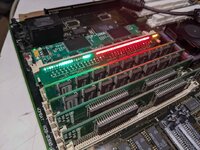zigzagjoe
Well-known member
This is intended to stack on the interposer board for use with in a quadra with bare metal code. So far I haven't come across much that would warrant a full revision of the board.... but very early days.Is your next version going to have the lights embedded? Or will you stack this on the interposer?
The problem is the emulated storage device's data is currently synthesized on the fly, so the file listing is fixed. I'm definitely thinking that I will at least have the internal log to a log "file", but the main problem is there isn't a graceful way to inform the host of changes (since the host rightly assumes storage devices don't just decide to change their contents for fun) nor is there a way to deal with the host caching data.You could have a text log file shown on the emulated storage device? Could even include the latest status in the filename "log - failed.txt".
I think I'm going to have to do a full USB disconnect and reconnect, breaking the serial connection as well as making the host complain about the drive going away unexpectedly...

